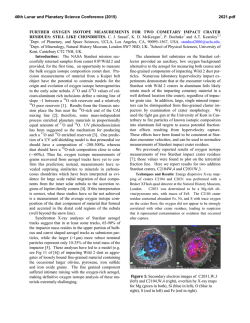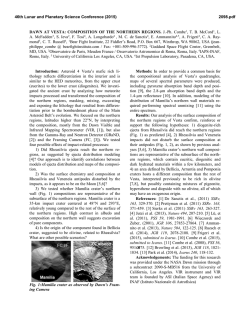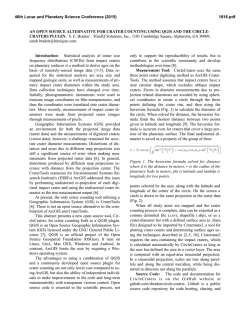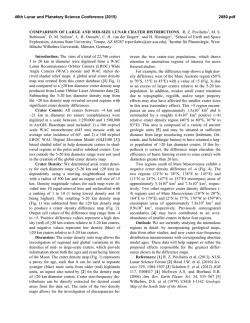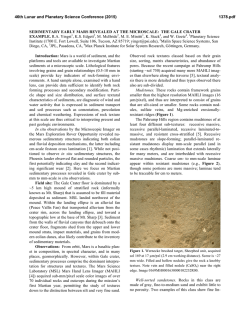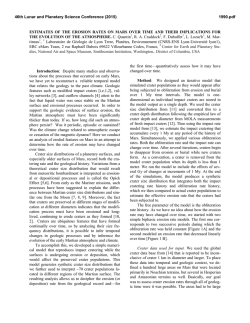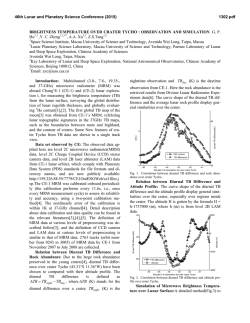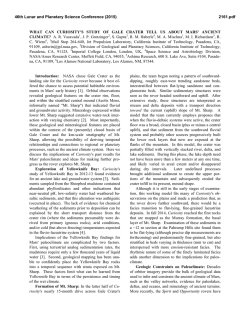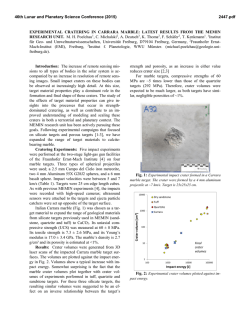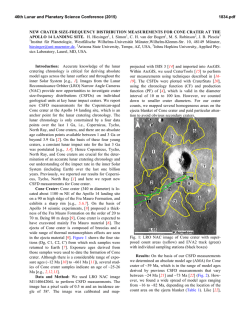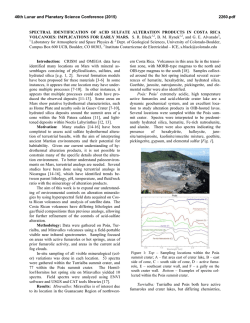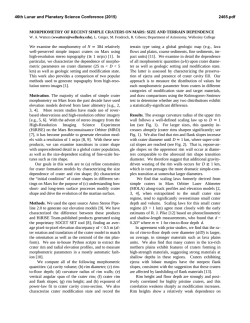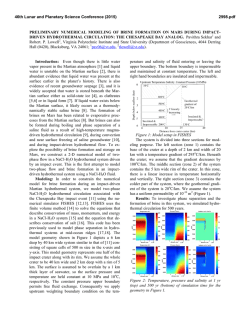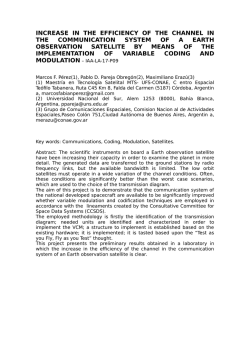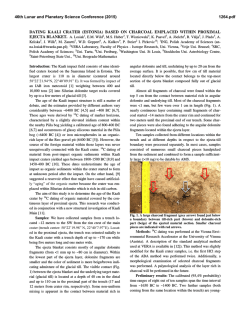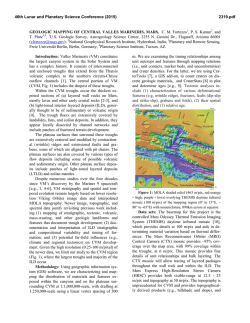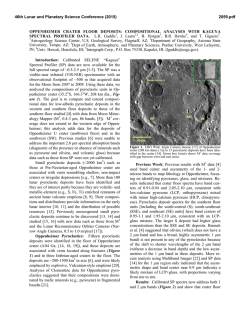
215 km Morokweng Impact Structure, South Africa
46th Lunar and Planetary Science Conference (2015) 1739.pdf THE ~215 km MOROKWENG IMPACT STRUCTURE, SOUTH AFRICA-AN INTEGRATED SURVEY FROM SATELLITE IMAGERY. Z. A. Botes1, S. Misra1 and M. A. G. Andreoli2,3, 1SAEES, University of KwaZulu-Natal, Durban- 4000, South Africa ([email protected]; [email protected]), 2School of Geosciences, University of Witwatersrand, Wits-2050, South Africa, 3Necsa, Pretoria-0001, South Africa ([email protected]). Introduction: The Morokweng impact crater situated in the North West Province of South Africa was formed ~145±2 Ma ago, i.e. close to the JurassicCretaceous (J-K) boundary, by an impact of LL-6 chondrite [1-5]. The target rocks are mostly Archaean granitoids with scattered occurrences of Archaean meta-volcanics (ca. 3.0 to 2.9 Ga) and Proterozoic metasediments (quartzite, carbonates and banded iron formation) of the overlying Griqualand West Supergroup [6]. At present, the structure is mostly buried beneath the <70 Ma Kalahari Group of continental sediments and calcrete; consequently, debate remains about its actual diameter [6]. Estimates based on geophysical interpretations range from ~340 km [7] to ~70 km [8, 9]. Our preliminary observation on the Landsat 1 imagery suggests that the diameter of this crater could be between 160 and 200 km [10]. The J-K boundary represents a period of geological upheavals and environmental disruption including large meteorite impacts, important sub-marine volcanism and climatic changes [11]. Therefore, better information on the actual size and other impact-related structures of the Morokweng crater (e.g. radial, faults and dykes) is important for evaluating the relationship between large impacts and possible terrestrial catastrophe. In the present work, we therefore present some important features observed in the satellite images of the Morokweng crater. Satellite imagery: Our preliminary Inspection of the Landsat satellite imagery showed that Landsat-1 (previously Earth Resources Technology Satellite ERTS) provided the best contrast from its Band 1 (Green, 500-600 nm) Multi-spectral Scanner (MSS) (Fig. 1). Available imagery dated from 1973 with two frames infilled from 1979 and 1980. The panchromatic images were interpreted in conjunction with a 100 x 100 m DEM. We have also attempted to evaluate the dimension and structure of the Morokweng crater using the radar images provided by Alaska Satellite Facility. However, these images cannot be fruitfully used for this crater due to their low level of penetration. Morphology of Morokweng crater: The area of the Morokweng crater generally has low relief (mean 1224m AMSL) with minimum and maximum elevations of 1019 and 1520m AMSL, respectively (Fig. 1). The crater consists of higher ground in the SE half and lower ground in the NW half of the area. The segments of semi-circular ridges (5-8 km wide) rising 150-200 m above the surrounding topography, with a probable geographic center at 26o40/07//S, 23o58/54//E, mark the maximum visible extension of the structure. Extrapolating the semi-circular ridges to a circle (yellow dashed circle in Fig. 1) we find a diameter of the structure to be around 215 km, encompassing an area of ~32,000 km2. Within this circular structure, there is also another circular feature (black dashed line) which could be concentric with the bigger circular feature even though its center appears marginally displaced towards NW relative to the center of the larger circular feature. Some lineations have also been identified along the periphery of the inner structure, two subparallel to the structure and one perpendicular. Note that the centre of both rings lies 30 – 40 km ESE of the centre of the impact melt sheet. Fig. 1. False colour Landsat-1 satellite image of Morokweng crater showing the present extension of the crater (yellow dashed circle) and development of concentric ring like structures within the crater (black dashed circle).Red dot: approximate centre of impact melt sheet [1, 2, 3, 7, 8, 9] We have also examined the variation of elevations along the cross sections AA/ and BB/ of the inferred circular feature (Fig. 2, 3). The central part of the ring is always found to have higher elevation by ~ 1.25 times of its present margin. 46th Lunar and Planetary Science Conference (2015) The river system presently existing in this terrain has originated from the central highland of the structure and is mainly flowing towards NW along sub-parallel channels flowing in the SE-NW direction (Fig. 4). A few channels also flowing towards south from the central highland of the structure. Fig. 2. Shaded DEM of Morokweng crater showing present topographic elevation of the structure. 1739.pdf proterozoic supracrustal rocks of the Griqualand West Supergroup. An integrated study on the magnetic, gravity and borehole data [13] indicated the presence of 5 concentric rings with an outermost diameter of 240 km for this crater. Our study confirms that this structure has a minimum diameter of 215 km at present, and represents one of the largest terrestrial impact craters. Finally, the eccentric position of the well-studied Morokweng impact melt sheet [1, 2, 3. 7, 8, 9, 13] relative to the Landsat rings may be the result of a post-impact structural rebound [13]. Fig. 4. Landsat-1 Band 1 satellite image of Morokweng crater showing the distribution of present drainage system. References: [1] Andreoli M.A.G. et al. (1995) in Centennial Fig. 3. Cross-sections A-A’ and B-B’ as indicated on Figure 2. Discussion: Our detailed analysis of the Landsat-1 satellite image reveals a number of arc segments consistent with and improves on previous observations made on different sets of Landsat images [10, 13]. Accordingly, the Morokweng area appears as a light coloured, sub circular region rimmed by a segmented, incomplete arc of dark coloured outcrops of Palaeo- Geocongress, Johannesburg, 541-544. [2] Hart R. J. et al. (1997) Earth Planet. Sci. Lett., 147, 25-35. [3] Koeberl C. et al. (1997) Geology, 25, 731-734. [4] McDonald I. et al. (2001) Geochim. Cosmochim. Acta, 65, 299-309. [5] Maier W. D. et al. (2006) Nature, 441, 203-206. [6] Koeberl C. and Reimold W. U. (2003) Geochim. Cosmochim. Acta, 67, 1837-1862. [7] Corner B. et al. (1997) Earth Planet. Sci. Lett., 146, 351-364. [8] Henkel H. et al. (2002) J. Appl. Geophys., 49, 129-147. [9] Reimold W. U. et al. (2002) Earth Planet. Sci. Lett., 221-232. [10] Townsend C. et al. (2011) 74th MSM, abs. no. 5523. [11] Misra S. et al. (2014) 45th LPSC, abs. no. 1017. [12] Misra S. et al. (2011) 42nd LPSC, abs. No. 1102. [13] Andreoli M.A.G. et al. (2007) 10th SAGA Biennial Meeting, 4 pp.
© Copyright 2025
